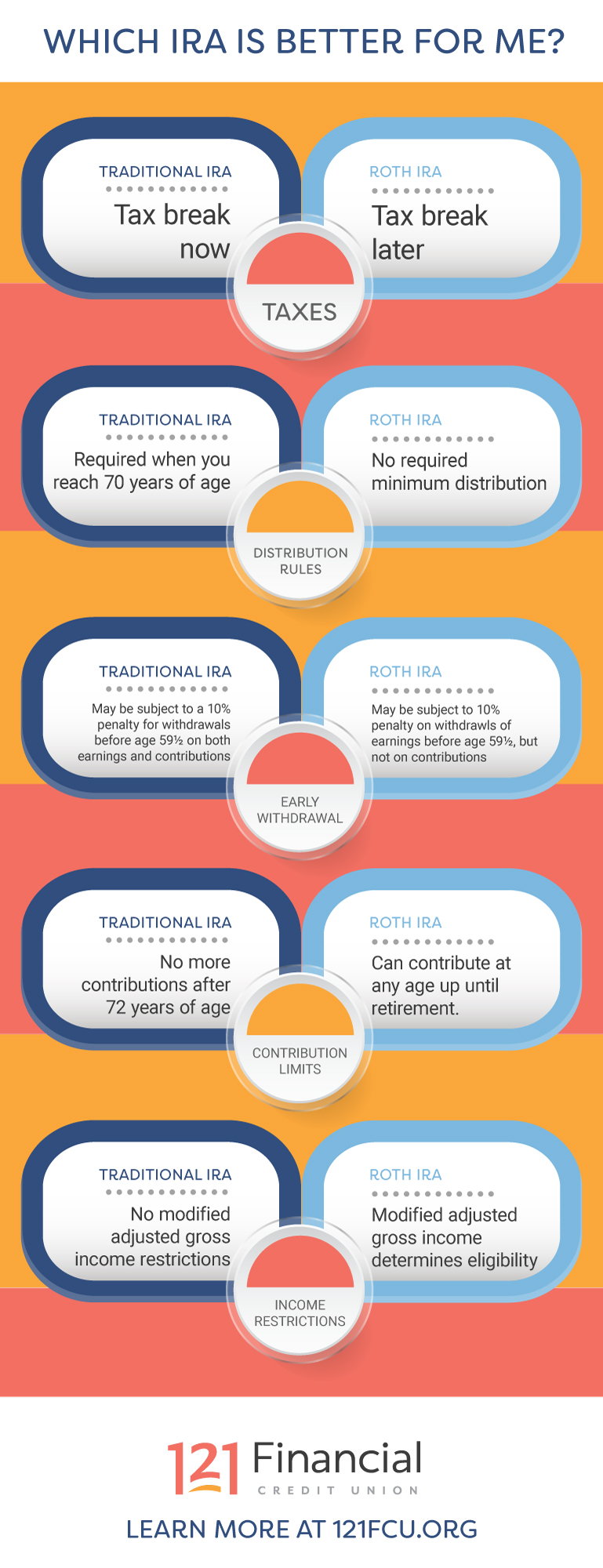
Roth vs Traditional IRA: Which is Better for Me?

IRAs (the abbreviation for individual retirement accounts) are a popular resource for millions of Americans saving for retirement. Most banks, brokers and financial institutions offer several different types of IRAs, but the two most common are the traditional IRA and the Roth IRA.
Both offer several unique advantages that can help bolster your retirement savings but choosing which one is right for you depends on your current financial situation and your retirement goals.
Who Can Open an IRA?
Anyone with earned income can open an IRA, but there are restrictions and limitations. For example, although Roth IRAs and traditional IRAs have many similarities, they are both taxed in different ways. Also, traditional IRAs have income restrictions while Roth IRAs have no income limitations.
The differences can have a big impact on how much you save for retirement and how much you can withdraw from your account. Here we will discuss the differences and similarities and cover some specific use cases and scenarios to help you decide which one will save you the most money for retirement.
How IRAs Work
When you invest in an IRA, you are typically investing in a basket of stocks, bonds, certificates of deposit or other assets. Some people like to put their money in safer IRAs that almost guarantee returns such as certificates of deposits, fixed annuities, mutual funds or money-market accounts. Although all investments carry some risk, these assets are widely recognized as the safest to own.
Other people like to take on a little more risk hoping to produce higher returns. Stocks, bonds and commodities are examples of investments that tend to make more money than conservative investments.
Savvy, more experienced investors often invest in futures contracts or foreign currencies. Keep in mind that IRAs do not invest in options or derivatives. If you are an inexperienced investor, you should avoid these IRAs until you gain the knowledge and experience to take on more risk.
As we discussed earlier, the two most popular IRAs are the Traditional IRA and the Roth IRA. If you are thinking about investing in one of these accounts to build retirement income, you should understand their similarities and differences.
Roth vs Traditional IRA: What is the Difference?
Here are some key differences between these two retirement accounts:
1. Taxes
When you are comparing a Roth IRA and traditional IRA, the biggest difference you will see is how the government taxes each account. Both offer generous tax breaks, but when you can take advantage of those breaks are different.
Taxes on Traditional IRA's
First, traditional IRAs are tax-deductible during the year you make your contributions. The advantage here is the deductions lower your adjusted gross income, which lowers your federal and state tax liability for that year.
However, you will pay taxes on any withdrawals (distributions) you make during retirement. The amount you pay will depend on the income tax rates the government sets on incomes at that time.
Taxes on Roth IRA's
Conversely, Roth IRAs do not allow you to take deductions when you make contributions. Therefore, you cannot reduce your taxable income for that year. However, there is a distinct advantage to these non-deductible contributions. You are essentially paying taxes on your contributions today, so you do not have to pay taxes on withdrawals you make during retirement.
2. Roth vs Traditional IRA: Distribution Rules
When you stack up a Roth vs traditional IRA, you will notice an important difference between their distribution rules. First, a distribution is how much money you are required to take out (withdrawal) from your account when you retire.
Traditional IRA RMD
When you reach 70 years of age, a traditional IRA requires you to take what are known as required minimum distributions (RMDs). Whether or not you need the money, you must take RMDs on traditional IRAs. How much you must withdrawal depends on your IRA's account balance and your age. The IRS makes adjustments to RMDs each year, so you visit its website to calculate your real-time RMD.
Roth IRA RMD
Roth IRAs do not have required minimum distributions when you retire. You can leave the money in your IRA for as long as you want. If you decide to transfer your Roth IRA account balance to your heirs, they will not have to pay income taxes on any withdrawals they make. However, your beneficiaries must make withdrawals or transfer the balance into their own Roth IRA.
3. Withdrawing Funds Early
 If you take funds out of your traditional IRA before the age of 59 1/2, it is considered an early withdrawal. The government requires you to pay income taxes and a 10 percent penalty on the withdrawal. Roth IRAs are quite a bit different.
If you take funds out of your traditional IRA before the age of 59 1/2, it is considered an early withdrawal. The government requires you to pay income taxes and a 10 percent penalty on the withdrawal. Roth IRAs are quite a bit different.
Since you are already paying taxes on your contributions, a Roth IRA allows you to withdraw money tax and penalty free before the age of 59. However, you can only withdraw money from your total contributions.
If you take out money from your Roth IRAs earnings, such as the yield on stocks or interest earned from a CD, you must pay income taxes and the 10 percent penalty.
There are circumstances where the IRS will waive the penalty and the taxes when you withdraw funds from your Roth IRA earnings for specific reasons. You can also get the penalty waived on a traditional IRA (does not include taxes) for these circumstances:
- Have a permanent and total disability
- Paying for medical premiums after experiencing a job loss
- Health care costs exceed 7.5 percent of your gross income
- Buy, build or renovate a first home, up to $10,000
- Higher education expenses
- Upon your death, a beneficiary withdraws the funds
- A qualified financial hardship: Death of a spouse, job loss
4. How Much You Can Contribute
Both Roth IRAs and traditional IRAs limit how much and when you can contribute money. For example, you cannot contribute to a traditional IRA after 72 years of age. A Roth IRA lets you contribute money at any age as long you are working.
Additionally, the maximum amount you can contribute to an IRA as of 2020 is $6,000 before the age of 50. If you are 50 or older, you can contribute an additional $1,000 each year, which caps the maximum annual contribution at $7,000. You can also split up the contributions between a Roth IRA and traditional IRA so long as you do not exceed the contribution limits.
5. Income Restrictions
One of the benefits of a traditional IRA is it does not have income limits. You can earn as much money as you want (before the age of 72) and still invest in a traditional IRA. However, your total income will affect how much of your IRA you can deduct from your taxes.
Roth IRAs do have income limits. Since they provide significant tax advantages, the IRS sets income restrictions to prevent higher-paid workers from benefiting more than workers with average or lower incomes. The income restrictions for Roth IRAs as of 2020 are:
- If you are single, your adjusted gross income cannot exceed $139,000. Contributions start to phase out when your adjusted gross income exceeds $124,000.
- If you are married, your adjusted gross income cannot exceed $206,000. Contributions begin to phase out when your adjusted gross income exceeds $196,000.
What is Better, a Traditional IRA or a Roth IRA?
Asking yourself or an investment advisor "Roth vs traditional IRA which is better" often leads to different answers. Since both IRAs offer tax benefits at different times, you should ask yourself if you want to save on income taxes today or when you retire.
You also will have to look at your income today and what your income might be when you retire. For example, some people might have smaller incomes when they retire than when they were working. If that is the case, you might want to choose a Roth IRA now so you can pay income taxes while you are earning more money.
Taxes on IRA Withdrawals After Retirement
If your income is smaller during retirement, you will not be burdened by additional taxes on any withdrawals you make during retirement since you chose a Roth IRA. Remember, Roth IRAs do not have a tax requirement on withdrawals.
However, some people might have higher taxable incomes during retirement. For example, you might receive income from investments, social security benefits or decide to take on a part-time job. All that additional money you make during retirement is subject to income taxes.
Deductions and Credits When Retiring
You also might lose valuable deductions and tax credits when you retire. If you pay off your mortgage, you no longer have interest deductions. If your children move out when they hit adulthood, you can no longer claim them as dependents (assuming they do move out).
There is a distinct possibility your taxable income might increase although you no longer work full-time. Again, a Roth IRA might be the better choice today to save on the withdrawal taxes you would pay during retirement if you chose a traditional IRA.
IRA Frequently Asked Questions
Here are some frequently asked questions and answers about Roth and traditional IRAs for new investors:
How do you open a Roth or traditional IRA?
Opening either account is not as difficult as it may seem. You can contact us today toll-free at 1-800-342-2352 to learn more about Roth and traditional IRAs. One of our investment experts will walk you through the application process and help you choose an IRA that fits your retirement needs.
Can you invest in a Roth IRA and traditional IRA at the same time?
You can invest in both a traditional IRA and Roth IRA. However, your annual contribution as of 2020 cannot exceed $6,000 if you are younger than 50 and $7,000 if you are 50 and over.
When can you contribute to an IRA during any given year?
The deadline for making contributions to an IRA is the tax deadline for that year, which is usually April 15. Tax deadline extensions are not included.
What is MAGI?
This is the acronym for modified adjusted gross income. Your MAGI is important because it determines whether you are allowed to invest in a Roth IRA. It also determines whether you can deduct contributions to your IRA.
The IRS calculates your MAGI by using your adjusted gross income and adding back some deductions and any tax-exempt interest income you may have earned. Your MAGI does not affect whether you can contribute to a traditional IRA since there are no income limits.
If you have a retirement plan at work, can you still contribute to an IRA?
If you contribute to a retirement plan at work, you can still contribute to a Roth IRA or a traditional IRA. However, what you contribute to your workplace plan could affect how much you can deduct from a traditional IRA each year. Contact us today and speak with one of our representatives about the possible tax implications.
For more information about IRAs or other investment tools that will help you build your retirement portfolio, please contact us today!

